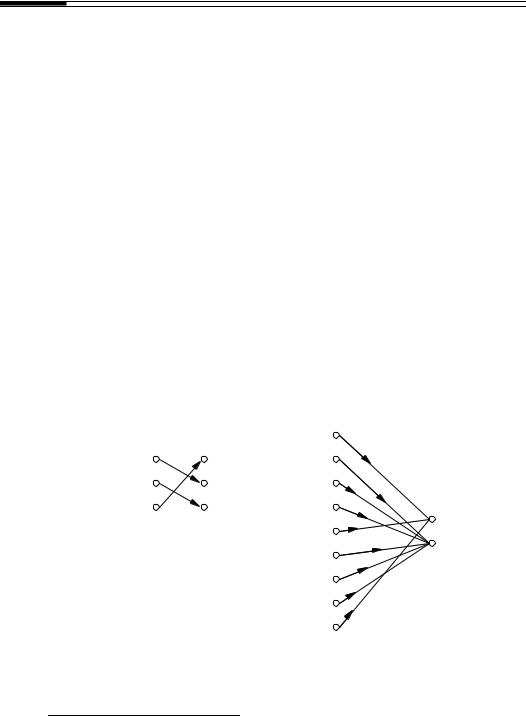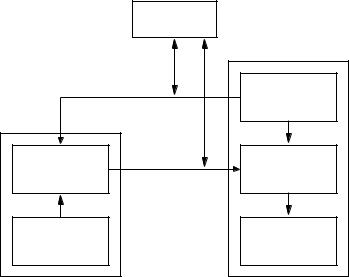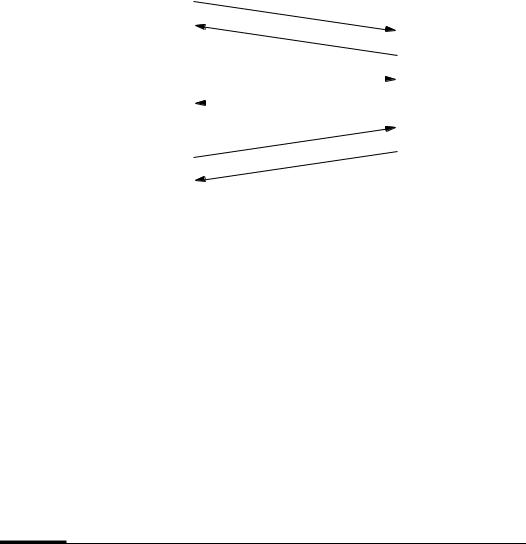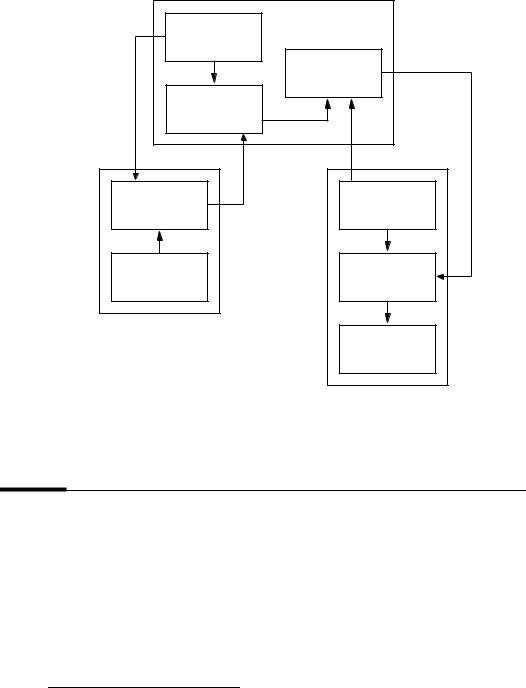
- •preface
- •1.1 Introduction
- •1.5 Symmetric-key Encryption
- •1.6 Digital Signatures
- •1.8 Public-key cryptography
- •1.9 Hash Functions
- •1.11 Key Management
- •2.1 Probability Theory
- •2.2 Information Theory
- •2.3 Complexity Theory
- •2.4 Number Theory
- •2.5 Abstract Algebra
- •3.3 RSA Problem
- •3.8 Composite Moduli
- •4.1 Introduction
- •4.2 Primality Tests
- •4.5 Irreducible Polynomials
- •6. Stream Ciphers
- •7. Block Ciphers
- •8. Public-Key Encryption
- •10. Authentication
- •11. Digital Signatures
- •A.2 Crypto Proceedings
- •A.3 Eurocrypt Proceedings
- •References
- •Index

22 |
Ch. 1 Overview of Cryptography |
1.6 Digital signatures
A cryptographic primitive which is fundamental in authentication, authorization, and nonrepudiation is the digital signature. The purpose of a digital signature is to provide a means for an entity to bind its identity to a piece of information. The process of signing entails transforming the message and some secret information held by the entity into a tag called a signature. A generic description follows.
Nomenclature and set-up
•M is the set of messages which can be signed.
•S is a set of elements called signatures, possibly binary strings of a fixed length.
•SA is a transformation from the message set M to the signature set S, and is called a signing transformation for entity A.3 The transformation SA is kept secret by A, and will be used to create signatures for messages from M.
•VA is a transformation from the set M × S to the set {true,false}.4 VA is called a verification transformation for A’s signatures, is publicly known, and is used by other entities to verify signatures created by A.
1.41Definition The transformations SA and VA provide a digital signature scheme for A. Occasionally the term digital signature mechanism is used.
1.42Example (digital signature scheme) M = {m1,m2,m3} and S = {s1,s2,s3}. The left side of Figure 1.10 displays a signing function SA from the set M and, the right side, the
corresponding verification function VA. |
|
|
|
|
(m1, s1) |
m1 |
s3 |
(m1, s2) |
m2 |
s1 |
(m1, s3) |
m3 |
s2 |
(m2, s1) |
|
|
True |
|
SA |
(m2, s2) |
False
(m2, s3) (m3, s1) (m3, s2) (m3, s3)
VA
Figure 1.10: A signing and verification function for a digital signature scheme.
3The names of Alice and Bob are usually abbreviated to A and B, respectively.
4M × S consists of all pairs (m, s) where m M, s S, called the Cartesian product of M and S.
§1.6 Digital signatures |
23 |
Signing procedure
Entity A (the signer) creates a signature for a message m M by doing the following:
1.Compute s = SA(m).
2.Transmit the pair (m,s). s is called the signature for message m.
Verification procedure
To verify that a signature s on a message m was created by A, an entity B (the verifier) performs the following steps:
1.Obtain the verification function VA of A.
2.Compute u = VA(m,s).
3.Accept the signature as having been created by A if u = true, and reject the signature if u = false.
1.43Remark (concise representation) The transformations SA and VA are typically characterized more compactly by a key; that is, there is a class of signing and verification algorithms publicly known, and each algorithm is identified by a key. Thus the signing algorithm SA of A is determined by a key kA and A is only required to keep kA secret. Similarly, the verification algorithm VA of A is determined by a key lA which is made public.
1.44Remark (handwritten signatures) Handwritten signatures could be interpreted as a special class of digital signatures. To see this, take the set of signatures S to contain only one element which is the handwritten signature of A, denoted by sA. The verification function simply checks if the signature on a message purportedly signed by A is sA.
An undesirable feature in Remark 1.44 is that the signature is not message-dependent. Hence, further constraints are imposed on digital signature mechanisms as next discussed.
Properties required for signing and verification functions
There are several properties which the signing and verification transformations must satisfy.
(a)s is a valid signature of A on message m if and only if VA(m,s) = true.
(b)It is computationally infeasible for any entity other than A to find, for any m M, an s S such that VA(m,s) = true.
Figure 1.10 graphically displays property (a). There is an arrowed line in the diagram for VA from (mi,sj) to true provided there is an arrowed line from mi to sj in the diagram for SA. Property (b) provides the security for the method – the signature uniquely binds A to the message which is signed.
No one has yet formally proved that digital signature schemes satisfying (b) exist (although existence is widely believed to be true); however, there are some very good candidates. §1.8.3 introduces a particular class of digital signatures which arise from publickey encryption techniques. Chapter 11 describes a number of digital signature mechanisms which are believed to satisfy the two properties cited above. Although the description of a digital signature given in this section is quite general, it can be broadened further, as presented in §11.2.

24 |
Ch. 1 Overview of Cryptography |
1.7 Authentication and identification
Authentication is a term which is used (and often abused) in a very broad sense. By itself it has little meaning other than to convey the idea that some means has been provided to guarantee that entities are who they claim to be, or that information has not been manipulated by unauthorized parties. Authentication is specific to the security objective which one is trying to achieve. Examples of specific objectives include access control, entity authentication, message authentication, data integrity, non-repudiation, and key authentication. These instances of authentication are dealt with at length in Chapters 9 through 13. For the purposes of this chapter, it suffices to give a brief introduction to authentication by describing several of the most obvious applications.
Authentication is one of the most important of all information security objectives. Until the mid 1970s it was generally believed that secrecy and authentication were intrinsically connected. With the discovery of hash functions (§1.9) and digital signatures (§1.6), it was realized that secrecy and authentication were truly separate and independent information security objectives. It may at first not seem important to separate the two but there are situations where it is not only useful but essential. For example, if a two-party communication between Alice and Bob is to take place where Alice is in one country and Bob in another, the host countries might not permit secrecy on the channel; one or both countries might want the ability to monitor all communications. Alice and Bob, however, would like to be assured of the identity of each other, and of the integrity and origin of the information they send and receive.
The preceding scenario illustrates several independent aspects of authentication. If Alice and Bob desire assurance of each other’s identity, there are two possibilities to consider.
1.Alice and Bob could be communicating with no appreciable time delay. That is, they are both active in the communication in “real time”.
2.Alice or Bob could be exchanging messages with some delay. That is, messages might be routed through various networks, stored, and forwarded at some later time.
In the first instance Alice and Bob would want to verify identities in real time. This might be accomplished by Alice sending Bob some challenge, to which Bob is the only entity which can respond correctly. Bob could perform a similar action to identify Alice. This type of authentication is commonly referred to as entity authentication or more simply identification.
For the second possibility, it is not convenient to challenge and await response, and moreover the communication path may be only in one direction. Different techniques are now required to authenticate the originator of the message. This form of authentication is called data origin authentication.
1.7.1Identification
1.45Definition An identification or entity authentication technique assures one party (through acquisition of corroborative evidence) of both the identity of a second party involved, and that the second was active at the time the evidence was created or acquired.
Typically the only data transmitted is that necessary to identify the communicating parties. The entities are both active in the communication, giving a timeliness guarantee.

§1.8 Public-key cryptography |
25 |
1.46 Example (identification) A calls B on the telephone. If A and B know each other then entity authentication is provided through voice recognition. Although not foolproof, this works effectively in practice.
1.47Example (identification) Person A provides to a banking machine a personal identification number (PIN) along with a magnetic stripe card containing information about A. The
banking machine uses the information on the card and the PIN to verify the identity of the
card holder. If verification succeeds, |
A is given access to various services offered by the |
machine. |
|
Example 1.46 is an instance of mutual authentication whereas Example 1.47 only provides unilateral authentication. Numerous mechanisms and protocols devised to provide mutual or unilateral authentication are discussed in Chapter 10.
1.7.2Data origin authentication
1.48Definition Data origin authentication or message authentication techniques provide to one party which receives a message assurance (through corroborative evidence) of the identity of the party which originated the message.
Often a message is provided to B along with additional information so that B can determine the identity of the entity who originated the message. This form of authentication typically provides no guarantee of timeliness, but is useful in situations where one of the parties is not active in the communication.
1.49Example (need for data origin authentication) A sends to B an electronic mail message (e-mail). The message may travel through various network communications systems and be stored for B to retrieve at some later time. A and B are usually not in direct communication.
B would like some means to verify that the message received and purportedly created by A did indeed originate from A.
Data origin authentication implicitly provides data integrity since, if the message was modified during transmission, A would no longer be the originator.
1.8 Public-key cryptography
The concept of public-key encryption is simple and elegant, but has far-reaching consequences.
1.8.1 Public-key encryption
Let {Ee : e K} be a set of encryption transformations, and let {Dd : d K} be the set of corresponding decryption transformations, where K is the key space. Consider any pair of associated encryption/decryption transformations (Ee,Dd) and suppose that each pair has the property that knowing Ee it is computationally infeasible, given a random ciphertext c C, to find the message m M such that Ee(m) = c. This property implies that given e it is infeasible to determine the corresponding decryption key d. (Of course e and d are

26 |
Ch. 1 Overview of Cryptography |
simply means to describe the encryption and decryption functions, respectively.) Ee is being viewed here as a trapdoor one-way function (Definition 1.16) with d being the trapdoor information necessary to compute the inverse function and hence allow decryption. This is unlike symmetric-key ciphers where e and d are essentially the same.
Under these assumptions, consider the two-party communication between Alice and Bob illustrated in Figure 1.11. Bob selects the key pair (e,d). Bob sends the encryption key e (called the public key) to Alice over any channel but keeps the decryption key d (called the private key) secure and secret. Alice may subsequently send a message m to Bob by applying the encryption transformation determined by Bob’s public key to get c = Ee(m). Bob decrypts the ciphertext c by applying the inverse transformation Dd uniquely determined by d.
Passive
Adversary
e
UNSECURED CHANNEL
encryption |
c |
Ee(m) = c |
UNSECURED CHANNEL |
m |
|
plaintext |
|
source |
|
Alice |
|
key |
source |
d |
decryption |
Dd(c) = m |
m |
destination |
Bob |
Figure 1.11: Encryption using public-key techniques.
Notice how Figure 1.11 differs from Figure 1.7 for a symmetric-key cipher. Here the encryption key is transmitted to Alice over an unsecured channel. This unsecured channel may be the same channel on which the ciphertext is being transmitted (but see §1.8.2).
Since the encryption key e need not be kept secret, it may be made public. Any entity can subsequently send encrypted messages to Bob which only Bob can decrypt. Figure 1.12 illustrates this idea, where A1, A2, and A3 are distinct entities. Note that if A1 destroys message m1 after encrypting it to c1, then even A1 cannot recover m1 from c1.
As a physical analogue, consider a metal box with the lid secured by a combination lock. The combination is known only to Bob. If the lock is left open and made publicly available then anyone can place a message inside and lock the lid. Only Bob can retrieve the message. Even the entity which placed the message into the box is unable to retrieve it.
Public-key encryption, as described here, assumes that knowledge of the public key e does not allow computation of the private key d. In other words, this assumes the existence of trapdoor one-way functions (§1.3.1(iii)).
1.50 Definition Consider an encryption scheme consisting of the sets of encryption and decryp-

§1.8 Public-key cryptography |
27 |
|
|
c1 |
|
|
A1 |
Ee(m1) = c1 |
e |
|
|
|
|
|
Dd(c1) = m1 |
|
|
|
|
||
|
|
|
|
|
|
|
|
c2 |
|
A2 |
Ee(m2) = c2 |
|
Dd(c2) = m2 |
|
|
|
|||
|
|
|||
|
|
|
|
|
|
|
|
e |
|
|
|
c3 |
|
Dd(c3) = m3 |
A3 |
Ee(m3) = c3 |
|
|
|
e |
|
Bob |
||
|
|
|
||
|
|
|
|
|
Figure 1.12: Schematic use of public-key encryption.
tion transformations {Ee : e K}and {Dd : d K}, respectively. The encryption method is said to be a public-key encryption scheme if for each associated encryption/decryption pair (e,d), one key e (the public key) is made publicly available, while the other d (the private key) is kept secret. For the scheme to be secure, it must be computationally infeasible to compute d from e.
1.51Remark (private key vs. secret key) To avoid ambiguity, a common convention is to use the term private key in association with public-key cryptosystems, and secret key in association with symmetric-key cryptosystems. This may be motivated by the following line of thought: it takes two or more parties to share a secret, but a key is truly private only when one party alone knows it.
There are many schemes known which are widely believed to be secure public-key encryption methods, but none have been mathematically proven to be secure independent of qualifying assumptions. This is not unlike the symmetric-key case where the only system which has been proven secure is the one-time pad (§1.5.4).
1.8.2 The necessity of authentication in public-key systems
It would appear that public-key cryptography is an ideal system, not requiring a secure channel to pass the encryption key. This would imply that two entities could communicate over an unsecured channel without ever having met to exchange keys. Unfortunately, this is not the case. Figure 1.13 illustrates how an active adversary can defeat the system (decrypt messages intended for a second entity) without breaking the encryption system. This is a type of impersonation and is an example of protocol failure (see §1.10). In this scenario the adversary impersonates entity B by sending entity A a public key e which A assumes (incorrectly) to be the public key of B. The adversary intercepts encrypted messages from A to B, decrypts with its own private key d , re-encrypts the message under B’s public key e, and sends it on to B. This highlights the necessity to authenticate public keys to achieve data origin authentication of the public keys themselves. A must be convinced that she is

28 |
Ch. 1 Overview of Cryptography |
encrypting under the legitimate public key of B. Fortunately, public-key techniques also allow an elegant solution to this problem (see §1.11).
|
Adversary |
|
|
key |
|
|
|
source |
|
|
|
d |
|
encryption |
|
|
|
Ee(m) = c |
|
e |
|
|
|
decryption |
|
m |
|
Dd (c ) = m |
|
|
|
|
|
e |
|
encryption |
c |
key |
c |
|
|
||
Ee (m) = c |
|
source |
|
m |
|
d |
|
|
|
|
|
plaintext |
|
decryption |
|
source |
|
Dd(c) = m |
|
|
|
m |
|
A |
|
|
|
|
|
destination |
|
|
|
B |
|
Figure 1.13: An impersonation attack on a two-party communication. |
|
||
1.8.3 Digital signatures from reversible public-key encryption
This section considers a class of digital signature schemes which is based on public-key encryption systems of a particular type.
Suppose Ee is a public-key encryption transformation with message space M and ciphertext space C. Suppose further that M = C. If Dd is the decryption transformation corresponding to Ee then since Ee and Dd are both permutations, one has
Dd(Ee(m)) = Ee(Dd(m)) = m, for all m M.
A public-key encryption scheme of this type is called reversible.5 Note that it is essential that M = C for this to be a valid equality for all m M; otherwise, Dd(m) will be meaningless for m . C
5There is a broader class of digital signatures which can be informally described as arising from irreversible cryptographic algorithms. These are described in §11.2.

§1.8 Public-key cryptography |
29 |
Construction for a digital signature scheme
1.Let M be the message space for the signature scheme.
2.Let C = M be the signature space S.
3.Let (e,d) be a key pair for the public-key encryption scheme.
4.Define the signing function SA to be Dd. That is, the signature for a message m M
is s = Dd(m).
5. Define the verification function VA by |
|
true, |
if Ee(s) = m, |
VA(m,s) = false, |
otherwise. |
The signature scheme can be simplified further if A only signs messages having a special structure, and this structure is publicly known. Let M be a subset of M where elements of M have a well-defined special structure, such that M contains only a negligible fraction of messages from the set. For example, suppose that M consists of all binary strings of length 2t for some positive integer t. Let M be the subset of Mconsisting of all strings where the first t bits are replicated in the last t positions (e.g., 101101 would be in M for t = 3). If A only signs messages within the subset M , these are easily recognized
by a verifier. |
|
Redefine the verification function VA as |
|
true, |
if Ee(s) M , |
VA(s) = false, |
otherwise. |
Under this new scenario A only needs to transmit the signature s since the message m = Ee(s) can be recovered by applying the verification function. Such a scheme is called a digital signature scheme with message recovery. Figure 1.14 illustrates how this signature function is used. The feature of selecting messages of special structure is referred to as selecting messages with redundancy.
e |
key |
|
Ee(s) |
source |
|
m |
d |
|
s |
||
|
||
Accept |
Dd(m) = s |
|
if m M |
||
|
||
VerifierB |
m |
|
message |
||
|
||
|
source |
|
|
M |
Signer A
Figure 1.14: A digital signature scheme with message recovery.
The modification presented above is more than a simplification; it is absolutely crucial if one hopes to meet the requirement of property (b) of signing and verification functions (see page 23). To see why this is the case, note that any entity B can select a random element s S as a signature and apply Ee to get u = Ee(s), since S = M and Ee is public
30 |
Ch. 1 Overview of Cryptography |
knowledge. B may then take the message m = u and the signature on m to be s and transmits (m,s). It is easy to check that s will verify as a signature created by A for m but in which A has had no part. In this case B has forged a signature of A. This is an example of what is called existential forgery. (B has produced A’s signature on some message likely not of B’s choosing.)
If M contains only a negligible fraction of messages from M, then the probability of some entity forging a signature of A in this manner is negligibly small.
1.52Remark (digital signatures vs. confidentiality) Although digital signature schemes based on reversible public-key encryption are attractive, they require an encryption method as a primitive. There are situations where a digital signature mechanism is required but encryption is forbidden. In such cases these digital signature schemes are inappropriate.
Digital signatures in practice
For digital signatures to be useful in practice, concrete realizations of the preceding concepts should have certain additional properties. A digital signature must
1.be easy to compute by the signer (the signing function should be easy to apply);
2.be easy to verify by anyone (the verification function should be easy to apply); and
3.have an appropriate lifespan, i.e., be computationally secure from forgery until the signature is no longer necessary for its original purpose.
Resolution of disputes
The purpose of a digital signature (or any signature method) is to permit the resolution of disputes. For example, an entity A could at some point deny having signed a message or some other entity B could falsely claim that a signature on a message was produced by A. In order to overcome such problems a trusted third party (TTP) or judge is required. The TTP must be some entity which all parties involved agree upon in advance.
If A denies that a message m held by B was signed by A, then B should be able to present the signature sA for m to the TTP along with m. The TTP rules in favor of B if VA(m,sA) = true and in favor of A otherwise. B will accept the decision if B is confident that the TTP has the same verifying transformation VA as Adoes. Awill accept the decision if A is confident that the TTP used VA and that SA has not been compromised. Therefore, fair resolution of disputes requires that the following criteria are met.
Requirements for resolution of disputed signatures
1.SA and VA have properties (a) and (b) of page 23.
2.The TTP has an authentic copy of VA.
3.The signing transformation SA has been kept secret and remains secure.
These properties are necessary but in practice it might not be possible to guarantee them. For example, the assumption that SA and VA have the desired characteristics given in property 1 might turn out to be false for a particular signature scheme. Another possibility is that A claims falsely that SA was compromised. To overcome these problems requires an agreed method to validate the time period for which A will accept responsibility for the verification transformation. An analogue of this situation can be made with credit card revocation. The holder of a card is responsible until the holder notifies the card issuing company that the card has been lost or stolen. §13.8.2 gives a more indepth discussion of these problems and possible solutions.

§1.8 Public-key cryptography |
31 |
1.8.4 Symmetric-key vs. public-key cryptography
Symmetric-key and public-key encryption schemes have various advantages and disadvantages, some of which are common to both. This section highlights a number of these and summarizes features pointed out in previous sections.
(i)Advantages of symmetric-key cryptography
1.Symmetric-key ciphers can be designed to have high rates of data throughput. Some hardware implementations achieve encrypt rates of hundreds of megabytes per second, while software implementations may attain throughput rates in the megabytes per second range.
2.Keys for symmetric-key ciphers are relatively short.
3.Symmetric-key ciphers can be employed as primitives to construct various cryptographic mechanisms including pseudorandom number generators (see Chapter 5), hash functions (see Chapter 9), and computationally efficient digital signature schemes (see Chapter 11), to name just a few.
4.Symmetric-key ciphers can be composed to produce stronger ciphers. Simple transformations which are easy to analyze, but on their own weak, can be used to construct strong product ciphers.
5.Symmetric-key encryption is perceived to have an extensive history, although it must be acknowledged that, notwithstanding the invention of rotor machines earlier, much of the knowledge in this area has been acquired subsequent to the invention of the digital computer, and, in particular, the design of the Data Encryption Standard (see Chapter 7) in the early 1970s.
(ii)Disadvantages of symmetric-key cryptography
1.In a two-party communication, the key must remain secret at both ends.
2.In a large network, there are many key pairs to be managed. Consequently, effective key management requires the use of an unconditionally trusted TTP (Definition 1.65).
3.In a two-party communication between entities A and B, sound cryptographic practice dictates that the key be changed frequently, and perhaps for each communication session.
4.Digital signature mechanisms arising from symmetric-key encryption typically require either large keys for the public verification function or the use of a TTP (see Chapter 11).
(iii)Advantages of public-key cryptography
1.Only the private key must be kept secret (authenticity of public keys must, however, be guaranteed).
2.The administration of keys on a network requires the presence of only a functionally trusted TTP (Definition 1.66) as opposed to an unconditionally trusted TTP. Depending on the mode of usage, the TTP might only be required in an “off-line” manner, as opposed to in real time.
3.Depending on the mode of usage, a private key/public key pair may remain unchanged for considerable periods of time, e.g., many sessions (even several years).
4.Many public-key schemes yield relatively efficient digital signature mechanisms. The key used to describe the public verification function is typically much smaller than for the symmetric-key counterpart.

32 |
Ch. 1 Overview of Cryptography |
5.In a large network, the number of keys necessary may be considerably smaller than in the symmetric-key scenario.
(iv)Disadvantages of public-key encryption
1.Throughput rates for the most popular public-key encryption methods are several orders of magnitude slower than the best known symmetric-key schemes.
2.Key sizes are typically much larger than those required for symmetric-key encryption (see Remark 1.53), and the size of public-key signatures is larger than that of tags providing data origin authentication from symmetric-key techniques.
3.No public-key scheme has been proven to be secure (the same can be said for block ciphers). The most effective public-key encryption schemes found to date have their security based on the presumed difficulty of a small set of number-theoretic problems.
4.Public-key cryptography does not have as extensive a history as symmetric-key encryption, being discovered only in the mid 1970s.6
Summary of comparison
Symmetric-key and public-key encryption have a number of complementary advantages. Current cryptographic systems exploit the strengths of each. An example will serve to illustrate.
Public-key encryption techniques may be used to establish a key for a symmetric-key system being used by communicating entities A and B. In this scenario A and B can take advantage of the long term nature of the public/private keys of the public-key scheme and the performance efficiencies of the symmetric-key scheme. Since data encryption is frequently the most time consuming part of the encryption process, the public-key scheme for key establishment is a small fraction of the total encryption process between A and B.
To date, the computational performance of public-key encryption is inferior to that of symmetric-key encryption. There is, however, no proof that this must be the case. The important points in practice are:
1.public-key cryptography facilitates efficient signatures (particularly non-repudiation) and key mangement; and
2.symmetric-key cryptography is efficient for encryption and some data integrity applications.
1.53Remark (key sizes: symmetric key vs. private key) Private keys in public-key systems must be larger (e.g., 1024 bits for RSA) than secret keys in symmetric-key systems (e.g., 64 or 128 bits) because whereas (for secure algorithms) the most efficient attack on symmetrickey systems is an exhaustive key search, all known public-key systems are subject to “shortcut” attacks (e.g., factoring) more efficient than exhaustive search. Consequently, for equivalent security, symmetric keys have bitlengths considerably smaller than that of private keys in public-key systems, e.g., by a factor of 10 or more.
6It is, of course, arguable that some public-key schemes which are based on hard mathematical problems have a long history since these problems have been studied for many years. Although this may be true, one must be wary that the mathematics was not studied with this application in mind.
